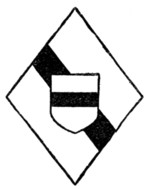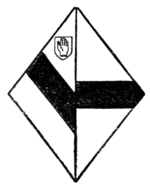heiress (Fig. 751). The widow of a knight has no way whatever of indicating that her husband was of higher rank than an ordinary untitled gentleman. The widow of a baronet, however, places the inescutcheon with the hand of Ulster upon her husband's arms (Fig. 752). I have often heard this disputed, but a reference to the Grant Books at the College of Arms (vide a grant of arms some years ago to Lady Pearce) will provide the necessary precedent. If, however, the baronetcy is of Nova Scotia, this means of indicating the rank cannot be employed. The widow of a peer (not being a peeress in her own right) uses a lozenge of her husband's and her own arms, with his supporters and his coronet (Fig. 753).
If a peeress, after marriage with a commoner, becomes a widow she bears on the dexter side a lozenge of her late husband's arms and superimposed thereupon her own on an escutcheon of pretence surmounted by a coronet. (The coronet, it should be noted, is over the escutcheon of pretence and not above the lozenge.) On the sinister side she bears a lozenge of her own arms alone with her supporters and with her coronet above the lozenge. The arms of the present Baroness Kinloss would show an example of such an arrangement of two lozenges, but as Lady Kinloss does not possess supporters these additions could not be introduced.
The laws of arms provide no way in which a married woman (other than a peeress in her own right) can display arms in her own right during the lifetime of her husband, unless this is to be presumed from the method of depicting the arms of a wife upon a hatchment. In such a case, a shield is used, usually suspended from a ribbon, identical with the shield of the husband, but omitting the helmet, crest, mantling, and motto.
Impalement is used occasionally in other circumstances than marriage, i.e. to effect conjunction of official and personal arms.
With rare exceptions, the official arms which exist are those of Archiepiscopal and Episcopal Sees, of the Kings of Arms, and of the



